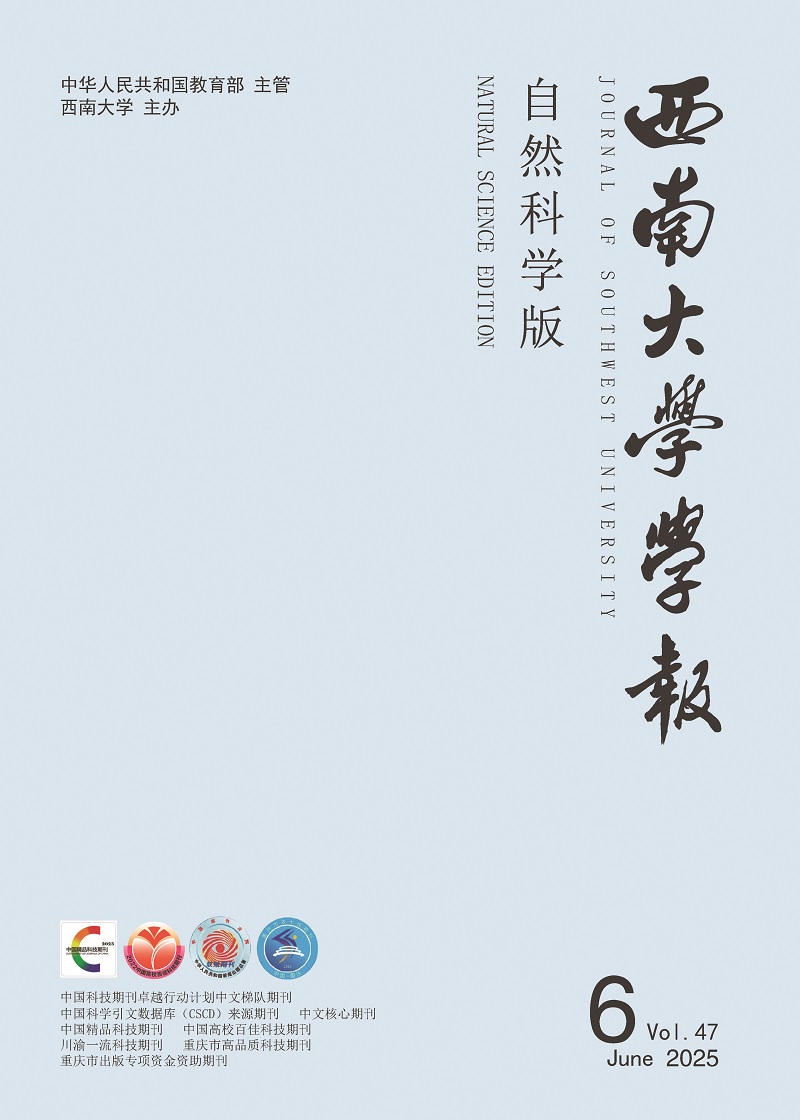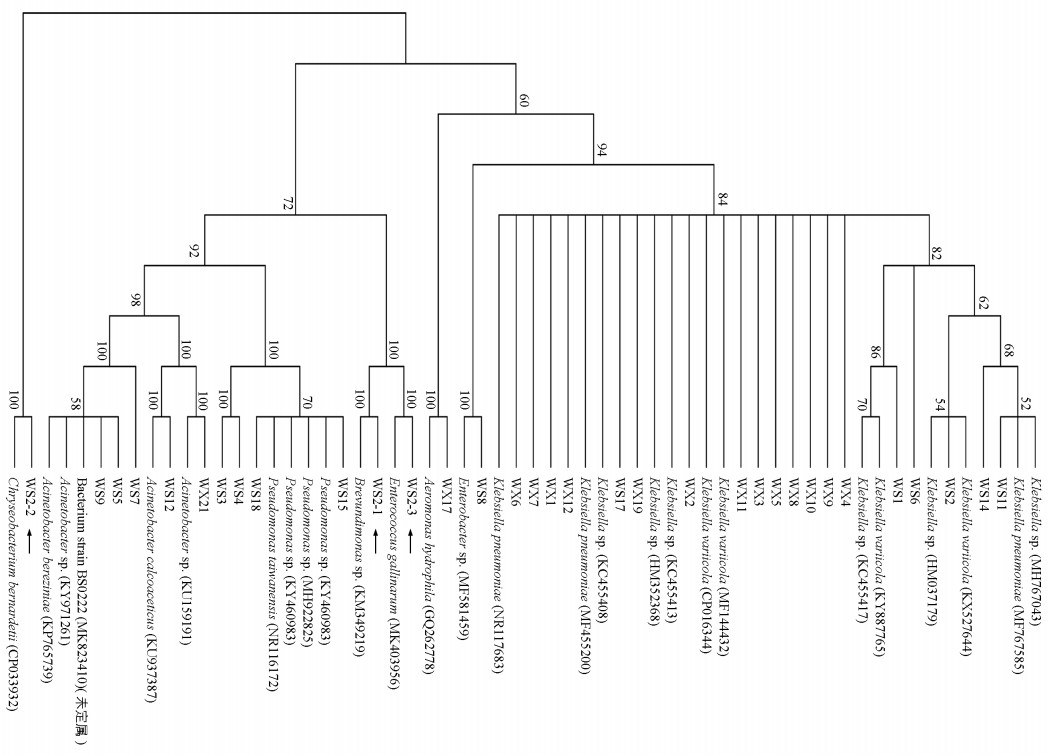-
随着昆虫肠道微生物研究的深入,越来越多的研究证明昆虫的肠道微生物种类和丰度会因食物、地域和生长发育等不同而出现差异[1-4];肠道微生物与昆虫的生长、生殖系统及消化系统发育、运动能力、迁徙聚集等有着密切的关系.了解昆虫肠道微生物的成分以及丰度是全面开展肠道微生物研究的基础,目前该方面研究的方法主要是运用传统培养方法结合高通量测序进行研究分析.
草地贪夜蛾(Spodoptera frugiperda)是世界重大迁飞性农林害虫,主要以禾本科植物(玉米、高粱、水稻)为食,危害巨大.自2019年1月从东南亚进入我国云南、广西地区,随着温度升高以及农作物的丰富,草地贪夜蛾随着季风快速迁徙至全国19个省份[5-8].前期美国和巴西开展了草地贪夜蛾肠道优势细菌的分离鉴定工作[9-10],但肠道微生物受环境影响很大,侵入我国的草地贪夜蛾的肠道微生物是如何组成的,国内尚无研究报道.近期本课题组也开展了这项工作,并发表了初步成果[11].但由于传统培养法的限制,很难一次完全分离鉴定获得其肠道所有的细菌种类,通过传统培养结合16S rDNA鉴定的方法,本课题组最近又从重庆巫山地区采食玉米的草地贪夜蛾肠道中分离获得3株细菌.
HTML
-
草地贪夜蛾幼虫采自重庆巫山地区玉米田中.
-
马铃薯琼脂培养基(PDA):马铃薯200.0 g,葡萄糖20.0 g,琼脂15.0 g,蒸馏水至1 000 mL.
改良LB培养基(LBG):胰蛋白胨10.0 g,酵母提取物5.0 g,NaCl 10.0 g,葡萄糖5.0 g,琼脂15.0 g,蒸馏水至1 000 mL.
牛肉膏蛋白胨培养基(NA):牛肉膏5.0 g,蛋白胨10.0 g,NaCl 5 g,琼脂15.0 g,蒸馏水至1 000 mL.
-
微生物裂解直接PCR试剂盒,Takara;PCR扩增引物27F:5′-AGAGTTTGATCCTGGCTCAG-3′;1492R:5′-GGTTACCTTGTTACGACTT-3′,由生物工程(上海)股份有限公司合成;1×Taq MasterMix(purple),北京博迈德基因技术有限公司.
-
在超净工作台上,将活的草地贪夜蛾幼虫浸泡于75%的乙醇中5 min,进行表面消毒.然后,取出中肠置于无菌1.5 mL EP管中,加1 mL灭菌的磷酸缓冲液(PBS)后充分震荡,以此为原液备用.
-
取100 μL制备的肠道原液于新的1.5 mL EP管中,加入900 μL灭菌PBS配制成10-1稀释液,递次稀释为10-2和10-3备用.各取10-2和10-3稀释100 μL涂布于不同的固体培养基上,30 ℃培养箱中培养24~72 h.随机挑选单菌落,在分离培养基上进行单斑划线获得纯培养,并染色观察.
-
1) 取50 μL裂解液于灭菌的1.5 mL EP管中.
2) 用灭菌的牙签从平板上挑取单菌落,置于EP管中搅动几下后取出.
3) 80 ℃热变性15 min后,低速离心,取1~5 μL裂解后的上清液作为PCR反应的模板.
4) 用细菌通用引物27F和1492R对上述模板进行PCR扩增细菌16S rDNA序列.反应体系(50 μL)如下:模板5 μL,引物27F/1492R各1 μL,1×Taq MasterMix(purple) 43 μL.反应程序:96 ℃预变性10 min;96 ℃变性30 s,55 ℃退火30 s,72 ℃延伸1 min 30 s,35个循环;72 ℃延伸10 min.将扩增产物送至华大基因科技股份有限公司测序.
5) 将获得的16S rDNA基因序列在GenBank(http://blast.ncbi.nlm.nih.gov/Blast.cgi)与数据库已登录基因序列进行同源比对,下载GenBank中同源性较高序列,利用MEGA5.0软件,使用N-J法进行1 000次步长计算,构建系统发育树.同时将获得的16S rDNA基因序列与RDP数据的Classifer程序(https://rdp.cme.msu.edu/classifier/classifier.jsp)进行比对,获得同源性较高序列的相关信息.
1.1. 样本材料
1.2. 实验用的培养基
1.3. 主要试剂
1.4. 中肠内容物提取
1.5. 肠道细菌分离
1.6. 分离菌株的初步鉴定
-
采用PDA培养基、LBG培养基、NA培养基从巫山地区采集的草地贪夜蛾幼虫肠道中进一步分离,通过细菌通用引物27F/1492R对多个分离株进行PCR扩增测序获得其16S rDNA序列.将测序结果分别在GenBank和RDP两个数据库进行比对获得相关信息,最终鉴定获得3个我们前期未分离到的菌株,分别编号为WS2-1,WS2-2,WS2-3(表 1).
为进一步了解不同地区草地贪夜蛾肠道优势菌的遗传多样性,将本次实验的3个分离株16S rDNA序列结合课题组前期的数据[11],采用MEGA5.0软件N-J法构建系统发育树进行了系统发育分析[12].由图 1可以看出,巫山地区新分离获得的3个分离株是课题组前期未报道的,分别为短波单胞菌属(Brevundimonas)、金黄杆菌属(Chryseobacterium)以及肠球菌属(Enterococcus),其中WS2-2分离株与其他分离株的进化亲缘关系较远.
-
本研究通过纯培养的方法,进一步分离鉴定了入侵重庆巫山地区以玉米叶为食的草地贪夜蛾肠道微生物中前期未报道的3个菌属,分别为短波单胞菌属、金黄杆菌属以及肠球菌属.其中肠球菌属在巴西学者Luis Gustavo de Almeida等人从对农药具有抗性的草地贪夜蛾的肠道微生物研究文章中有报道[9];短波单胞菌属及金黄杆菌属两个菌属是第1次在草地贪夜蛾肠道中分离获得.结合巴西、美国以及本课题组前期的研究结果,重庆地区与美国宾州地区以及巴西地区的草地贪夜蛾肠道微生物优势菌存在一定的重合性,同时也存在明显的地区差异性.推测可能是因为同一物种肠道微环境具有一定的保守性,而地区环境差异也影响昆虫肠道微生物的组成[9-10].
综上,我们在前期研究的基础上,进一步从重庆巫山地区玉米田草地贪夜蛾的肠道中分离获得3株课题组未报道的细菌分离株,归于3个属.加上前期分离发现的4个属,巫山地区采食玉米的草地贪夜蛾所分离的细菌目前一共来自7个属.这些肠道微生物是否也会影响宿主的抗性、生长发育、迁飞,不同细菌之间的相互关系怎样,仍有待进一步研究.







 DownLoad:
DownLoad: